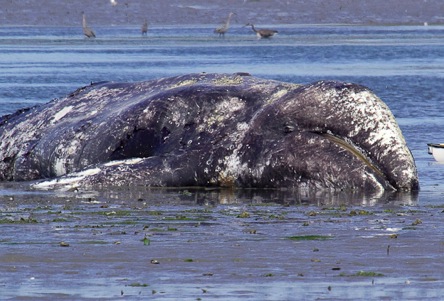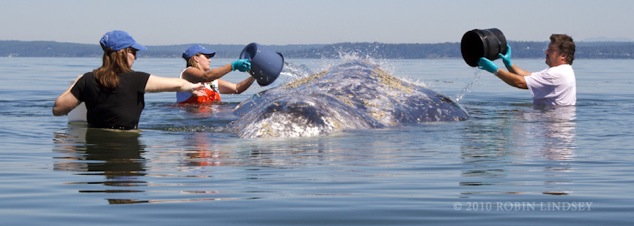everett gray whale
Gray whale strands on Tulalip Reservation
Jul/11/10 08:02 AM

The Everett gray whale stranded yesterday in Tulalip Bay on the Tulalip Reservation. Members of Seal Sitters, Sno-King Marine Mammal Stranding Network and WDFW responded to the scene. The mud flats of the bay restricted access to the whale which lay exposed to the extreme sun and heat. As the tide came in, however, the Tulalip Bay Fire Department zodiac managed to get a pump close enough to keep the whale wet and cool. A borrowed canoe allowed a stranding team member to get sheets to the scene so the whale could be covered and more protected. The tide finally covered the whale about 2pm. The Tulalip tribes honored the whale and prayed for him to get well. The repeated stranding behavior of this adult whale is indicative that he is most likely dying. The gray was spotted by NOAA on Saturday at 4:30 at Spee-Bi-Dah heading north into Port Susan. See related gallery of photos.
UPDATE:
7/13/10 Transient orcas were seen attacking the gray whale yesterday afternoon (Monday). Related story and video.
7/12/10 The gray was spotted this morning (Monday) at 6:30 am heading east toward Camano Island.
Gray whale strands in Everett
Jul/09/10 05:29 PM

Yesterday, however, the whale was marooned on the beach at low tide. Concerned neighbors in shorts and swimsuits assisted in keeping the exposed whale wet and cool. However, as the water rose and the whale became more active it became too dangerous for them to continue to help. Members of the NW Stranding Network (above photo from left, Jessie Huggins of Cascadia Research, Kristin Wilkinson of NOAA, and Brian Chittick of Snohomish-King County Stranding Network) labored for hours pouring buckets of water over the whale - until finally the incoming tide created a water level deep enough that he could swim free. They then boarded a boat with a team from WDFW Marine Mammal Investigations and monitored the whale until 2pm when he finally left the shallower waters and headed out into the strait.
Early this morning the whale stranded again and the Stranding Network responded. Approximately 2:30 this afternoon he was in 7-10 feet of water as the tide came in. NOAA is not optimistic about the whale’s survival based on his behavior and weakened condition.







